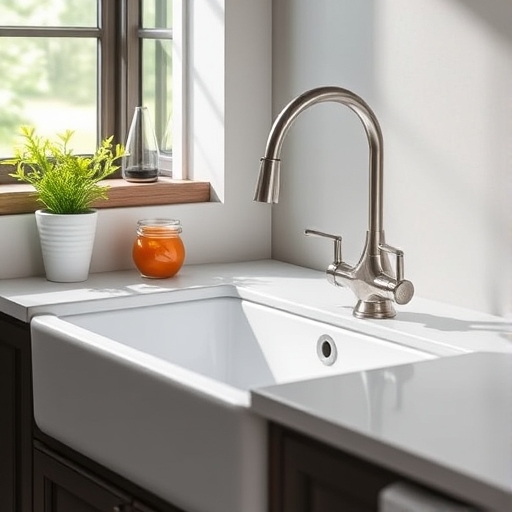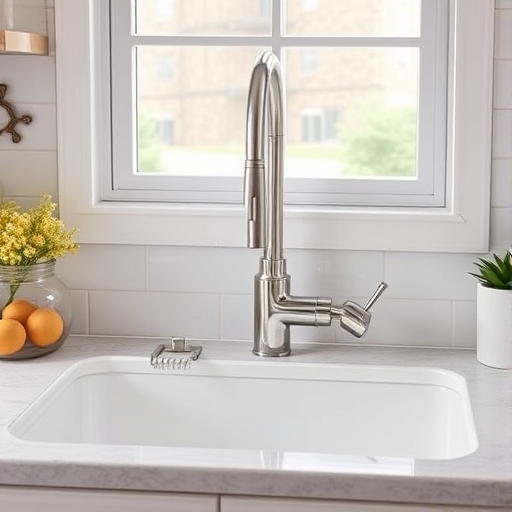Whenever you are reconstructing or improving your kitchen, there is one aspect that most people do not prioritise; which is how deep their sink should be. This is probably the last thing on your mind, but it shouldn’t be since the sink, more specifically the sink depth is critical to the entire kitchen workflow. Most people know how frustrating it can be to wash large pans, pots, blenders, and other equipment without the right depth for Kitchen Faucet Sink.
The tutorial aims to assist the DIY enthusiasts who love their kitchens, but work on a limited budget, or live in small dimensions and help them select a more practical sink depth. You will learn how depth contributes to kiosk and position placement attributes in addition to being able to determine the right depth for Kitchen Faucet Sink for your way of life by the end of this article.
The Reasons One Should Consider The Depth Of Their Sink
The first reason one should consider their sink depth is to enhance ergonomics within the kitchen area space. Ergonomics can prevent issues such as water splashes, lifted arms for extended times and poor handling of larger cookware when washing them. No matter how deep or shallow it is, washbasins are an important aspect of all households since they affect all aspects of ergonomics.
So if you consider yourself an advanced gourmet or a fast user of your home’s kitchen, the correct Depth for Kitchen Faucet Sink is extremely important – carry out proper research.

Things You Should Keep In Mind
1. Purpose
To begin, consider the average daily activities that involve your sink.
Routine Activities
In instances where the sink is only used to wash a few vegetables, a few light dishes, or prepare quick meals, then there is nothing wrong with a medium-deep sink (which we will define further on).
Extra Cooking Requirements
Do you regularly have to bake or cook big pans and pots? In that case, get a sink which is deeper than average; this will provide enough room to wash those big dishes without deflecting water all over.
Pro Tip: Write down the typical kitchen tasks in your family so that you do not select a sink which is deeper than what is practically cool.
2. Sink Material
With certain depths, certain sink material works best.
- Stainless Steel: Comprised of thin sheets, these sinks can withstand high usage and are a perfect choice for kitchen lovers. Quite simply, these can be used for just about anything on an everyday basis.
- Composite Sinks: These strong and stylish sinks are capable of medium and deep depths making them ideal for homes which regularly use large pots.
- Porcelain Sinks: Offer a more traditional style these ceramic or porcelain sinks are often used in a lot of constructions, however, they do best at medium depths as deeper porcelain sinks can be hard to clean and maintain.
3. Faucet Height
Also, consider your sink’s depth in relation to the faucet height!
- If your sink is deep, it is best to use a high faucet otherwise there will be water splashes.
- If the sink is shallow, then a low faucet should work well.
A good practice on this note is to always choose a sink depth that is suitable to the installed faucet.

Recommended Depths
Shallow Depth (5–7 Inches)
Pros:
- They are not hard to wash or clean.
- More suited for hand washing or cleansing the finer details.
Cons:
- Not ideal for more massive utensils like the baking trays or bigger stockpot.
- More prone to the bath water spillage.
Ideal For: Ideal in smaller kitchens or in case a secondary sink is needed in butler’s pantries.
Medium Depth (8–10 Inches)
Pros:
Visible and useful in diverse activities in the kitchen.
Holds a comfortable balance between size and ease of use.
Minimal fatigue on the arms and shoulders.
Deep Depth (11+ Inches)
Pros:
- Perfect for cleaning oversized pots, pans, and cookware
- Captures water splashes effectively
Cons:
- Can cause strain if you’re bending over for long periods
- May not fit well in small kitchen spaces
Ideal For: Serious home chefs or those with larger kitchen spaces and frequent heavy cleanups
Measuring Your Space
Before making a purchase, grab your measuring tape! Here’s how to ensure your sink depth fits your space seamlessly.
- Measure the Counter Cut-Out: Measure the inside diameter of your current sink opening if you’re replacing an existing sink.
- Consider Cabinet Size: Double-check that your under-sink cabinet has sufficient space to accommodate deeper sinks with their plumbing.
- Account for Plumbing: Avoid surprises by ensuring the faucet and pipes fit comfortably alongside your sink.
Tip: Don’t forget any surrounding kitchen features (e.g., windows, backsplash) that might clash with a deep sink or tall faucet setup.

Installation Considerations
Professional vs. DIY Installation
- Professional Installation: Perfect for deeper or complex sinks and ensures correct placement of plumbing and faucet heights.
- DIY Enthusiasts: Shallow and medium-depth sinks are much easier to install on your own. Just ensure you’ve accounted for factors like plumbing and countertop cuttings.
Adjustments for Different Depths
- For deeper sinks, be prepared to adjust the plumbing and potentially reinforce your cabinet structure.
- Always double-check your faucet height before finalizing your sink choice.
The Right Sink Depth Brings Long-Term Comfort
Your kitchen sink isn’t just a tool it’s part of your lifestyle. Whether you’re picking a shallow sink for a compact kitchen or choosing the depth to match your baking obsession, this decision will shape how you interact with your space every day.
Take your time to assess your needs, explore materials, and ensure compatibility with your existing kitchen features.
FAQ
A kitchen sink faucet is a plumbing fixture that controls the flow of water into the sink, often equipped with hot and cold water handles, sprayers, and filters for convenience.
No, a sink is the basin where water collects for washing, while a faucet is the fixture that delivers and controls the flow of water into the sink
A smart kitchen faucet uses motion sensors, voice activation, or touchless technology to turn water on/off, offering hands-free operation, water efficiency, and convenience
A stainless steel faucet is known for corrosion resistance, durability, and a modern look, making it ideal for long-lasting, hygienic, and easy-to-clean kitchen use
The three main types of kitchen faucets are:
Single-handle faucets , Easy one-hand control for temperature and flow.
Double-handle faucets , Separate controls for hot and cold water.
Pull-down or pull-out faucets, Flexible spray heads for better reach and cleaning





